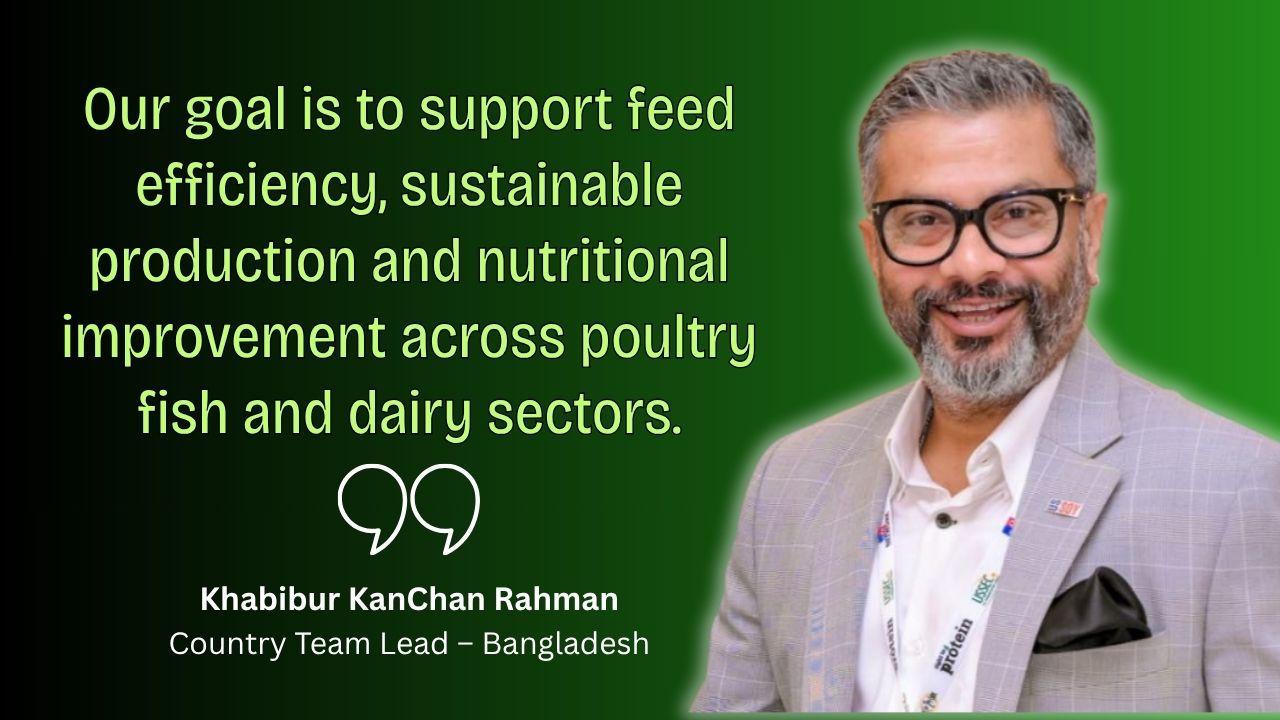The U.S. Soybean Export Council (USSEC) is playing a pivotal role in advancing Bangladesh’s animal protein sector by promoting the use of high-quality, sustainable U.S. Soy. With a focus on building capacity, improving feed quality and ensuring food security, USSEC has actively contributed to the modernization of the country’s feed and livestock industries. To learn more about USSEC’s initiatives in Bangladesh, Mr. Md. Khorshed Alam Jewel, Editro & CEO of Agrinews24.com interviewed Mr. Khabibur KanChan Rahman, Country Team Lead – Bangladesh, who shared in-depth perspectives on the organization’s mission, work and long-term strategy.
Khabibur KanChan Rahman with over a decade of experience in agri-trade, capacity building and sustainable feed development. He has played an integral role in expanding U.S. Soy’s presence across Bangladesh’s poultry, aquaculture and dairy sectors.
 AgriNews24.com: Please give our readers a brief overview of USSEC. What are the organization’s main goals and objectives?
AgriNews24.com: Please give our readers a brief overview of USSEC. What are the organization’s main goals and objectives?
Khabibur KanChan Rahman: USSEC is a global organization comprising U.S. soybean farmers, processors, exporters and agribusinesses working together to expand the value and utilization of U.S. Soy around the world. It is funded by U.S. soybean checkoff programs, USDA Foreign Agricultural Service (FAS) support and industry contributions. Our mission is to maximize market access, promote quality differentiation and establish long-term partnerships that position U.S. Soy as a sustainable and reliable source of global nutrition and energy. We operate in over 80 countries and focus on three strategic pillars—Differentiation, Elevation, and Attainment. Through technical assistance, capacity building, sustainability certification like the SSAP (Sustainability Assurance Protocol) and targeted market development. We help strengthen food systems and support agricultural advancement globally.
AgriNews24.com: When did USSEC begin its operations in Bangladesh and what types of activities is it currently engaged in?
Khabibur KanChan Rahman: USSEC formally began operating in Bangladesh in the early 2010s, But its foot print is here in Bangladesh since 1996. Since then, we have significantly expanded our engagement, working with crushers, local feed mills, industry associations, nutritionists and poultry farmers. Our work includes organizing technical training sessions, hosting soy conclaves and feed formulation seminars, facilitating soy-based feed adoption and implementing demonstration projects such as In-Pond Raceway Systems (IPRS) in aquaculture. We promote science-based feed practices and assist stakeholders with tools like the Nutrient Value Calculator and International Aquaculture Feed Formulation Database (IAFFD). Our goal is to support feed efficiency, sustainable production and nutritional improvement across poultry fish and dairy sectors.
AgriNews24.com: How is USSEC contributing to the animal protein sector in Bangladesh, particularly in the poultry, aquaculture, and dairy industries?
Khabibur KanChan Rahman: In Bangladesh’s poultry sector, which produces over 7.5 million metric tons of feed annually, U.S. soybean meal is widely used because of its superior digestibility, higher amino acid content and lower moisture levels. Integrators report up to 3% better performance when using U.S. Soy compared to alternatives. USSEC provides targeted training to nutritionists and millers, helping them enhance feed formulations and processing efficiency. In aquaculture, Bangladesh is one of the top five fish-producing nations globally. USSEC has introduced IPRS systems to improve fish yield and production efficiency, while also offering feed formulation training using IAFFD. These programs have raised feed conversion rates and supported sustainable aquaculture development. In dairy, although smaller in scale, we provide support for feed formulation and cattle nutrition using soybean meal. This sector is growing and USSEC is helping build technical capacity to enhance milk productivity and overall animal health.
AgriNews24.com: How is U.S. Soy being used in Bangladesh’s animal feed industry and what are the key differences between U.S. soybean/soymeal and those from local or other international sources?
Khabibur KanChan Rahman: U.S. Soy is highly valued in Bangladesh for its superior processing quality, high protein digestibility and consistent nutrient profile. Compared to Brazilian, Argentine or local soy sources, U.S. Soy offers lower moisture, brighter color, better grindability and reduced levels of anti-nutritional factors. These characteristics result in better pellet durability, more predictable feed formulations and improved animal performance. Our sustainability certifications like SSAP and SUSS ensure traceability and low-carbon sourcing, which are becoming increasingly important for integrators and feed millers. Through demonstration projects, formulation tools and hands-on training, USSEC helps feed manufacturers understand and leverage these advantages, making U.S. Soy the top choice for quality-conscious producers.
AgriNews24.com: What role does USSEC play in the development of Bangladesh’s feed sector? How is it supporting modernization and quality improvement in this industry?
Khabibur KanChan Rahman: USSEC acts as a catalyst for modernization in Bangladesh’s feed industry by providing technical guidance, capacity building and science-driven tools. We conduct seminars, workshops and customized training sessions for feed mill operators, nutritionists and integrators. These cover advanced feed formulation, extrusion technology, pellet quality and anti-nutritional factor management. Tools like the Nutrient Value Calculator and IAFFD support cost-effective, optimized formulation. We also introduce modern aquaculture technologies such as IPRS, offering practical demonstrations to encourage adoption. Furthermore, USSEC works with stakeholders to align practices with Bangladesh’s Feed Act and evolving quality standards. This has improved safety, efficiency and sustainability throughout the sector.
AgriNews24.com: How is USSEC supporting smallholder farmers in Bangladesh in terms of capacity building, technical knowledge and feed utilization?
Khabibur KanChan Rahman: Supporting smallholder farmers is a major focus of USSEC’s strategy in Bangladesh. We offer targeted technical workshops and hands-on training for small-scale feed millers, fish farmers and livestock producers. These sessions cover feed regulation compliance, feed formulation, nutrient balancing, and proper use of raw materials like U.S. soybean meal. Our IPRS demonstration sites in districts like Natore show farmers how soy-based feeds can significantly improve fish growth and yield. We also organize networking events that connect smallholders with commercial integrators and feed experts, helping them adopt best practices and improve feed quality. By promoting sustainability and traceability, we help smallholders prepare for long-term integration into formal and commercial markets.
AgriNews24.com: What kind of technical support does USSEC provide to enhance nutrition, sustainability and production efficiency in the animal protein supply chain?
Khabibur KanChan Rahman: USSEC provides comprehensive technical support across the feed and animal protein supply chain. We train stakeholders to use tools like the Nutrient Value Calculator and IAFFD to develop precise, cost-effective rations. We organize sessions on extrusion technology, pelleting and raw material handling to improve feed efficiency. We also emphasize the importance of sourcing verified, sustainable inputs like SSAP-certified U.S. Soy. Our workshops, site visits, and educational content equip feed mills and farmers with science-based knowledge to enhance productivity while reducing environmental impact. This integrated approach supports more resilient and efficient food systems in Bangladesh.
AgriNews24.com: In your opinion, how can U.S. Soy contributes to ensuring food security and meeting the growing protein demand in Bangladesh?
Khabibur KanChan Rahman: U.S. Soy contributes significantly to food security in Bangladesh by enabling higher-quality and more efficient animal protein production. Its consistent nutrient profile helps optimize livestock, poultry and aquaculture performance, making protein more affordable and accessible for consumers. As Bangladesh’s population grows and demand for protein increases, U.S. Soy provides a reliable, traceable and sustainable input that supports national goals in nutrition and agricultural modernization.
AgriNews24.com: What is USSEC’s current market share in Bangladesh, and are there any new plans or strategies for expanding your activities in the country in the coming years?
Khabibur KanChan Rahman: As of the fiscal year 2022–23, U.S. Soy holds approximately 37 percent of the soybean import market in Bangladesh, with a total import value of around USD 382 million. This makes the United States the 10th-largest soybean exporter to Bangladesh by value. Looking ahead, USSEC plans to expand its engagement by deepening technical collaborations, increasing outreach to feed producers, promoting SSAP-certified soy and scaling up demonstration projects like IPRS. Our goal is to support a resilient, high-performing, and sustainable animal protein sector in Bangladesh that can meet future food and nutrition challenges.
 Agrinews24 কৃষির সাথে, কৃষকের পাশে
Agrinews24 কৃষির সাথে, কৃষকের পাশে




















